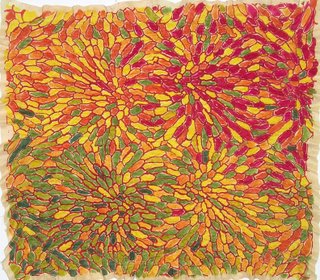
The finished work (slightly brighter than it actually is due to the flash).
When we left off last time, I had just finished painting it.
Next I used free motion embroidery to sew the silk onto a one metre piece of plain m-cotton. I've been learning to do this on an industrial sewing machine, which has been marginally overwhelming. The thread broke over one hundred times my first afternoon sewing it. I switched from cotton to polyester and back. I changed the needles on the machine. I switched machines. I switched embroidery feet. Finally, a million years and a day later, I discovered that 'tension' was the source my problems. It was simply set too tightly for such fine fabric. (Apparently adjusting the tension on the studio machines is very naughty, but it worked!) This is the back - you can see the knots. Most I was able to snip out later on.

Afterward, I soaked the entire piece in a lye bath for just over a minute. Natural cellulosic fibers shrink when they come into contact with lye (caustic soda and water). Loosely woven cotton and linen have worked best for me. Silk can be safely dipped for short periods of time and will not shrink. Other protein-based fibres, such as wool, dissolve and start breaking. I stitched the silk onto the m-cotton, anticipating that the m-cotton would shrink and cause the silk to pucker and buckle. Because I'm a protein based being, I'm all suited up.

Then I neutralised the fabric and washed it very well.

You can see the puckering effect up close here.

That's the end of the journey for the silk. For me, the journey was about combining different processes and practicing my free motion embroidery. It's given me lots of ideas for future projects.
I'm still knitting my Baudelaires, and in the meantime, I have a book terrific recommendation!

I recently ordered this from Amazon and it's the best book on weaving structure I've ever seen. If you've ever wanted to learn more about weave structures, wondered why satin weave needs five harnesses, been baffled by a cloth diagram, or simply wanted everything to make sense 'in your head' while you are weaving it, buy this. Alderman covers every iota of the warp and weft in great detail. I haven't finished it yet but I'm reading it from cover to cover - I never thought I'd say that about a book on structure.
Edit: My Secret Pal Questionnaire can be found HERE!
10 comments:
tut tut tut Say...
This is your secret pal (#9) - and you haven't done your questionaire yet....
just making contact...
Cheers,
SP9
Can't you flash me a bigger photo? I want to see it all....
That looks great!
Hi Say -
Thanks for you link to the SP questionaire - I don't have access to amazing yarns or fibres at good prices where I am (without spending the entire limit on one skein :)), but I do have something a little special planned for you. It will take a little work on my part, but it will be fun creating :) Enjoy being spoiled..
Cheers,
your secret pal :)
The silk is gorgeous! So many steps! You have the patience of a saint and for that you get terrific results! New blog layout is great too, I love the banner photo, it's really cool.
I don't know which I'm impressed with more, your silk or your stick-to-itivness. The silk piece is lovely. I felt excited anticipation as I scrolled down the page.
And now it's my turn to be influenced by your book recommendation!
Those are gorgeous! How did you learn how to make those beautiful pieces?? All I can say is WOW/
/hostess nic
What patience you have! I am such an instant results girl. And I'm not sure how old you are, but I'm 52 (but holding at 50) and planning to skip maturity and go directly to my second childhood. Yippee!!
http://shirleygoodwin.blogspot.com
That is just beautiful!!!
I love the book too, just make sure you check out the corrections on Handwoven's website. I found out after the fact.
Post a Comment